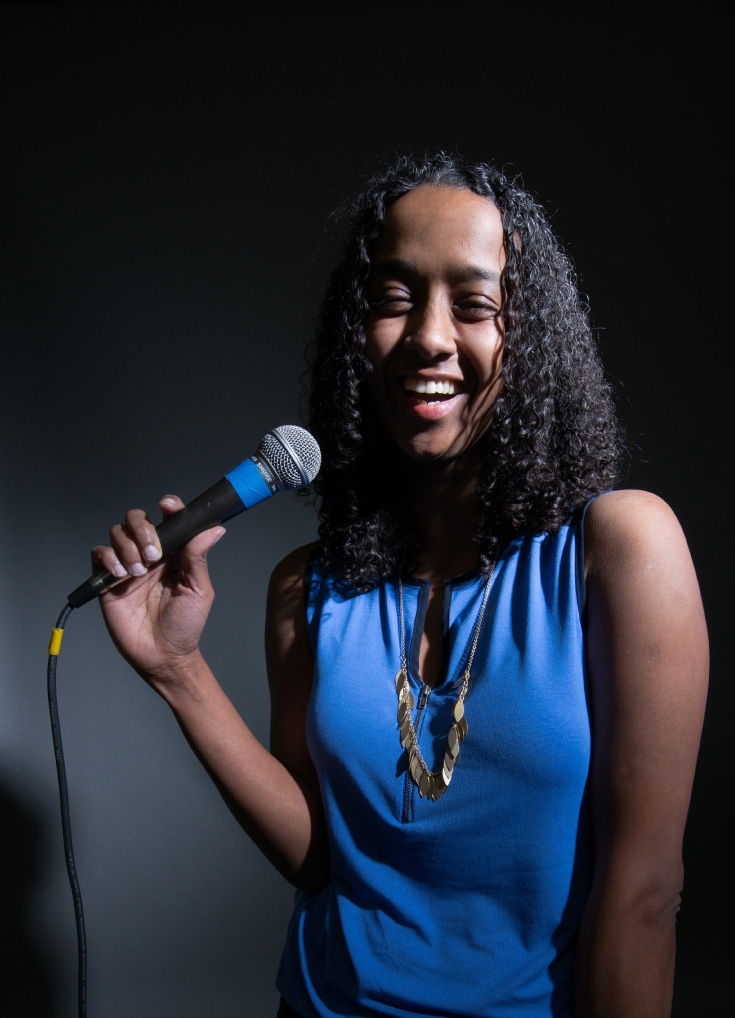When Nardos Osterhart wanted to practice public speaking for her day job, she turned to unconventional training to help her master the art of delivery.
Instead of working with a speaking coach, the registered nurse and manager at a major health care organization in Grand Rapids took to the stage as a stand-up comic to hone her presentation skills.
She planned to do it for a year, but that was three years ago.
“I saw myself improving as a comic, and finding acceptance from other comics who have become dear friends,” said Osterhart, who even won the Funniest Person in Grand Rapids competition in 2013. “You’re also chasing after a high if you’ve had a great set. Either you hope to personally top the last time you were on stage or must erase the memory of a failed and miserable experience.”
Today, Osterhart — a political refugee from Ethiopia, registered nurse, wife and mother — continues to moonlight as a stand-up comedian.
But three years on, she still remembers the jolt of booking her first gig. When the idea popped into her head, she went straight to Dr. Grins’ website and emailed Stu McCallister, the comedy club’s MC. Almost instantly, McCallister got back to her with a date.
“I felt a rush of nervousness and excitement,” Osterhart said. “He said, ‘You’ll have three minutes to do your material,’ and I thought, ‘What material?’”
Osterhart had just a few weeks to prepare before her big Dr. Grins debut. To get comfortable onstage, she practiced her set at area open mic nights at the Riverfront Hotel and Tip Top Deluxe in Grand Rapids.
“When you’re new, (three minutes) feels like an eternity,” she said.
Osterhart said it took about nine months to a year for her to finally get comfortable being on stage in front of an audience. But in gaining confidence, she also admits that she stuck with familiar material for too long. It became her crutch while on stage.
“I did not give up my early material for such a long time because so much of me was like, ‘Don’t screw this up.’ It’s almost a script,” she said. “I think that was part of the learning process in terms of getting comfortable on stage.”
As she learned and evolved as a comic, Osterhart has been able to build relationships and earn the respect of fellow comics.
“She has a good stage presence, very likable,” McCallister said. “You always see a smile on her face. You want her to succeed.”
Osterhart’s stand-up has also snowballed into a co-hosting gig with McCallister on his LMNOPodcast, where she helps balance his perspective and comedy style, he said.
|
Nardos Osterhart with Laugh Riot Dolls Dr. Grins at the B.O.B. |
“She’s completely different from myself,” McCallister said. “She’s a female, she’s African American, she actually has a real job and a family and is responsible … and I’m just telling stupid jokes.”
Osterhart admits, however, that her path to stand-up comedy was an unlikely one. Born in Ethiopia, her family left the region to escape political turmoil. They relocated to Germany for two years until they were granted political asylum in the United States. In 1982, the family moved five-year-old Nardos to Oklahoma.
“My parents divorced, but my father was a real proponent of us assimilating into American culture and my mother is very much, ‘Hold onto your culture and your traditions,’” Osterhart said.
Although she hasn’t been to Africa in nearly 14 years, Osterhart plans to taking her nine-year-old twin daughters in the future so they can better understand their heritage.
“My girls are having such a different experience from the one I had as an immigrant,” she said. “They were born here, so there’s always this desire to instill in them, ‘Don’t forget where we came from’ in terms of culture and also in terms of all the advantages and comforts of this life. So I think it would be important for them to understand that identity because living here in West Michigan, they’re not at all tied or in touch with my Ethiopian heritage.”
Osterhart found her way to Grand Rapids years after she immigrated to America. While attending the University of Oklahoma, she met her husband and moved with him to the city after graduation. It wasn’t until years later — and the birth of her twins — that Orterhart would try her hand at comedy.
“I think the thing that’s interesting about my story … is that I’m 37 and I’m doing stand-up,” she said. “You’re never too (old) to try something different and figure out who you are.”
Her next big gig comes this month at Gilda’s LaughFest, where she is part of the Laugh Riot Dolls comedy show on March 12.
“I love that time of year and I love that long stretch of going downtown and seeing all those banners and all that promotion and that huge yellow smile,” Osterhart said about LaughFest. “It makes you think we’re really unique. It’s a small town, but it’s a big event.”
The 90-minute Laugh Riot Dolls show Osterhart is performing in is a female-focused collection of beginners (the Baby Dolls) and experienced (the Laugh Riot Dolls) comedians.
“This is going to be a good show,” said Heather Kozlakowski,founder of the Laugh Riot Dolls. “Not only are these women funny, but these are good, supportive women. And that’s what Nardos is. She’s a good, supportive woman and she’s funny."
While the LaughFest show will feature an all-female lineup, the Laugh Riot Dolls aren’t exclusive to women.
“It grew into a very, very supportive female environment,” Kozlakowski said. “It’s also not exclusive to females. I’ve put on the Laugh Riot Dolls featuring Boy Toys. I’ve done two of those shows last year and I want to do more of those shows.”
One of the other reasons Osterhart has continued after her one-year stand-up goal is so she can represent women in a male-dominated field.
“There aren’t enough female voices,” she said. “So I feel a like there’s a need to kind of carry that torch because there’s plenty of material out there regarding men and what they’re interested in, but when it comes to women and their experiences, it’s kind of underrepresented.”
As for her initial reason for getting into stand-up, well, she says she’s killing it in those presentations for her day job.
“I think I’ve come a long way. I’m more comfortable in my job, I’m more comfortable in presentations and addressing larger groups,” she said. “If strangers can laugh at you when you’re trying to be funny and (you make them feel) lighthearted about things, then it shouldn’t be that hard to deliver a serious bit of facts or data to people in terms of being persuasive and guiding them toward your goal.”
While she’s succeeded in becoming a better public speaker as a result of her stand-up act, Osterhart isn’t quite ready to give up comedy. In fact, she has her sights set on even bigger goals.
“This year … I would like to do a very comfortable, routine, 30-minute set, I would say once a month if I can get booked,” Osterhart said. “What I’d like to do is go and do those 30 minutes, be interrupted a few times during that set and not even feel phased by it. That to me is the mark of a real professional and a person who is really comfortable on stage, who really knows her material and is willing to play with the crowd a little bit and then get back to where they were.”





